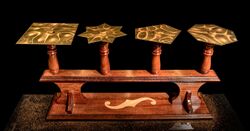Physics:Chladni's law
From HandWiki
Short description: Law in quantum mechanics
Chladni's law, named after Ernst Chladni, relates the frequency of modes of vibration for flat circular surfaces with fixed center as a function of the numbers m of diametric (linear) nodes and n of radial (circular) nodes. It is stated as the equation
where C and p are coefficients which depend on the properties of the plate.[1]

For flat circular plates, p is roughly 2, but Chladni's law can also be used to describe the vibrations of cymbals, handbells, and church bells in which case p can vary from 1.4 to 2.4.[2] In fact, p can even vary for a single object, depending on which family of modes is being examined.
References
- ↑ Rossing, Thomas D.; Fletcher, Neville H. (2004), Principles of Vibration and Sound, Springer, pp. 73–74, ISBN 9780387405568, https://books.google.com/books?id=SgBF0j2OfKMC&pg=PA73.
- ↑ Fletcher, Neville Horner; Rossing, Thomas D. (1998), The Physics of Musical Instruments, Springer, p. 680, ISBN 9780387983745, https://books.google.com/books?id=9CRSRYQlRLkC&pg=PA680.
External links
- A Study of Vibrating Plates by Derek Kverno and Jim Nolen (Archived 27 July 2011)
 |
